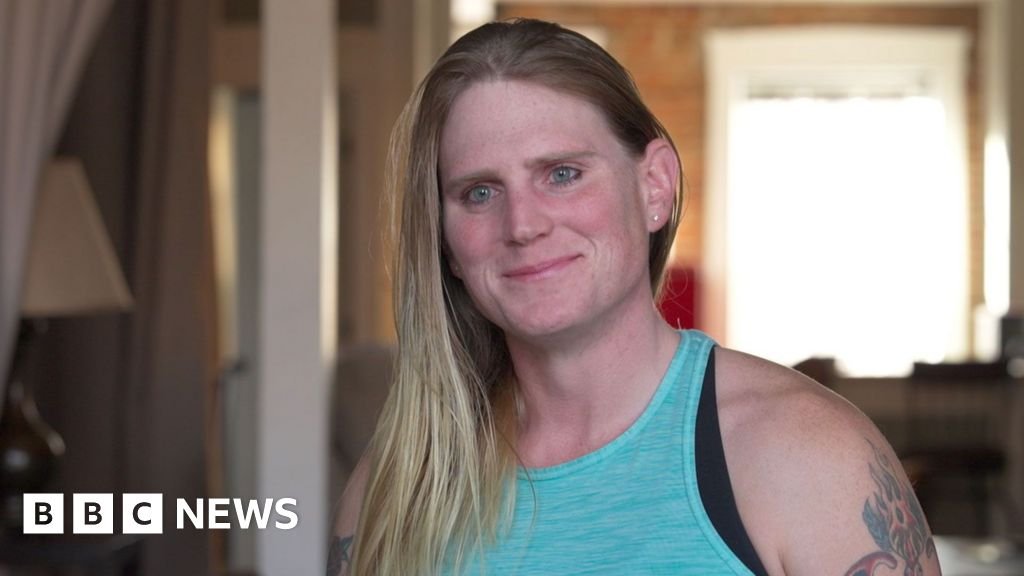
Trans troops in US military ‘in survival mode’ as ban on serving kicks in
2025-06-30 23:40:35
BBC World Service
 BBC
BBCAfter 17 years in the US Army, Maj Kara Corcoran, 39, was preparing to graduate from an elite military leadership programme.
But there was a complication.
Two days before the ceremony, Kara was told that she would need to conform to male regulations, which meant wearing male uniform and cutting the long blonde hair she had grown since she told the Army she identified as a woman in 2018.
The directive had come from the Pentagon, and filtered down through her chain of command at Fort Leavenworth, Kansas.
“Nothing about me is a man, but we’re going to force me into male regs just so I can walk across the stage with my peers,” she said in the hours leading up to the ceremony. “It’s not my choice to cut my hair. I’m doing it because I have to.”
Kara is one of several thousand transgender people affected by a ban, announced by President Trump in January, that prevents them from serving in any job in the US military.
A previous ban in his first term focused on new recruits and allowed some exceptions, particularly for those already serving. The 2025 policy removes virtually all of the exceptions.
Official figures say there are about 4,200 transgender service members in the US armed forces, however other estimates are much higher, at about 10,000.
 Kara Corcoran
Kara CorcoranThe new policy states that a history or diagnosis of gender dysphoria – where a person feels their gender differs from their sex registered at birth – is “incompatible with the high mental and physical standards necessary for military service”.
An executive order outlined President Trump’s position that “the Armed Forces have been afflicted with radical gender ideology” and that the policy would ensure staff were “free of medical conditions or physical defects that may reasonably be expected to require excessive time lost from duty for necessary treatment or hospitalization”.
The order also stated that “a man’s assertion that he is a woman, and his requirement that others honor this falsehood, is not consistent with the humility and selflessness required of a service member”.
A Gallup poll in February this year suggested that 58% of Americans “favor allowing openly transgender men and women to serve in the US military, but support has declined from 71% in 2019 and 66% in 2021”.
Critics have called the ban discriminatory and legal challenges have been filed from serving transgender officers and human rights groups.
Since February, the BBC has followed the lives of Maj Kara Corcoran and an officer in the Navy, Lt Rae Timberlake, as they navigate the uncertainty of their military careers. They have shared their thoughts and feelings in a personal capacity, not as spokespeople for the US military or other colleagues.
A career in question

Kara has spent most of her adult life in the US Army. Her combat deployments included time in Afghanistan where she was both a platoon leader and a company commander, when she was living as a man, before she transitioned. Since then, she says she has legally changed her name and gender and uses female pronouns.
Transgender people were disqualified from all jobs in the military until 2016, but over the past decade, as governments have changed, US policy has flip-flopped.
- 2016: Obama lifts ban on trans people serving, allowing them access to funding through the military for gender-related treatment
- 2017: Trump announces ban on trans people serving, citing medical costs and potential disruptions
- 2021: Biden signs order restoring the right of trans people to serve
- 2025: Trump announces new ban and bases are told to initiate separation proceedings against personnel with gender dysphoria
“For a long time, I stayed silent,” says Kara. When she joined up in 2008, women were not allowed in combat positions either.
Kara married a woman and had children, although the relationship broke down and ended as she grappled with her identity.
Kara came out as a transgender woman in 2018 and began her hormonal and surgical transition. She says she had the support of her commanding officers, who were still working to the previous set of guidelines, despite Trump’s 2017 ban. She tells the BBC that the transition improved her ability to serve.
“It’s made me more focused, more resilient,” she says. “There’s a common misconception that transitioning is a liability. For me, it’s been the opposite.”
 REUTERS/Carlos Barria
REUTERS/Carlos BarriaNow, with Trump’s latest policy in effect, Kara has been told that unless she leaves voluntarily, she may be forced out of the service against her will through a process called involuntary separation.
Involuntary separation happens when someone is discharged and they do not choose to leave of their own accord. It can affect any service member, not just people in combat roles.
As well as losing their jobs, people can also potentially lose benefits, such as pensions, healthcare and disability provisions.
The Department of Defense said that if someone went involuntarily they may get half what they would get if they left voluntarily – the difference could be tens of thousands of dollars.
Despite this, Maj Kara Corcoran says she does not want to walk away.
“I’m not going to get voluntarily separated,” she says. “I’ll go through the involuntary separation and what that looks like and how horrific they want to make that for me and other service members.”
‘The single dumbest phrase in military history’

Others such as former US Navy Seal, Carl Higbie, support Trump’s ban, though. Carl now hosts a TV show on the conservative network Newsmax.
He believes that transgender people are not fit for service in the US military, arguing that gender dysphoria may require ongoing medical care and accommodations that could affect deployability.
“You can’t take Ritalin [which is used to treat ADHD] or certain types of prescription medications and be an eligible service member in combat. Why should you be on hormone therapy, which we know has sometimes emotional effects?” he asks.
When asked if he thought that biological women, who may be on other medications containing hormones, such as treatment for the menopause, are fit to serve in the armed forces, he said: “I think there are certain times where we should be more concerned about killing bad guys than making sure that we have gender quotas on a combat operation.”
The ban on transgender service members is part of a broader shift in US military policy – Defence Secretary Pete Hegseth, a Trump appointee and former army officer, has moved to eliminate diversity, equity, and inclusion programmes.
“I think the single dumbest phrase in military history is ‘our diversity is our strength’,” Hegseth said at a Pentagon event in February.
And in April, he posted on X that he “proudly ended” the Women, Peace and Security programme, an initiative to invite more women and girls to be part of conflict resolution. He called it a distraction from the core task of “war-fighting”.
 EPA-EFE/REX/Shutterstock
EPA-EFE/REX/ShutterstockA family on the brink of change
Many had seen the policy shift coming. In the early hours of 6 November, when Donald Trump secured his victory in the 2024 US presidential election, Lt Rae Timberlake made a decision.
A non-binary navy officer, Rae joined the Navy aged 17 and has served aboard the nuclear-powered aircraft carrier USS Nimitz and in the Middle East.
Rae falls under the trans umbrella because, although they were registered female at birth, they identify as neither male nor female and use they/them pronouns.
Rae says that coming out as non-binary in 2020 and transitioning brought clarity to their identity. “The moment I heard the word ‘non-binary’, I knew it fit,” they told the BBC.
But with the 2024 Trump victory, Rae felt the clock was ticking on their career. They requested to transfer from their West Coast base, to a base closer to family in the east, who could give them support.
 Rae Timberlake
Rae TimberlakeRae, their wife and daughter moved in the middle of a school term, in the anticipation that a possible separation from the Navy was imminent.
“It felt like the safest move for us, in case I was forced to leave the service,” says Rae.
They add that they weren’t surprised by President Donald Trump’s executive order in January, or a memorandum from the Department of Defense the following month.
The memo specified that military bases must identify service members diagnosed with or exhibiting symptoms of gender dysphoria. The final deadlines to come forward voluntarily were eventually set as 6 June for active-duty personnel and 7 July for reserve and National Guard members.
In May, the Department of Defense said 1,000 service personnel had self-identified as trans, but there has been no update of the number since then.
The military has 30 days from a deadline to start involuntary separation proceedings.
The memo includes a provision for people to be considered for a waiver on a case-by-case basis. There are a few conditions including that staff must have “never attempted to transition to any sex other than their sex”.

By the time the memorandum was published, Rae had taken a new post in Maryland, and the family was adjusting to their new home.
“Watching Rae lose their career, it’s painful,” their wife, Lindsay, says. “We’re in survival mode. We haven’t had time to connect as a family. We just keep making hard choices.”
For Rae, the emotional cost has been high. They have decided they want more control over the future, so have requested to retire from the Navy, and believe that in doing so have self-identified for voluntary separation. The application hasn’t been accepted yet, but Rae believes it will be.
They expect the financial implications to be substantial. Without completing 20 years of service, Rae says they will likely forfeit eligibility for a military pension. They estimate pension payments could have added up to about $2.5m (£1.8m) over the course of their retirement.
A legal and political battle
While the Department of Defense says the ban will maintain consistent medical and readiness standards across the forces, opponents, argue that the policy targets a vulnerable group unfairly.
Three lawsuits have been filed challenging its legality.
In one high-profile ruling, a federal judge blocked the ban temporarily, citing concerns over its constitutionality and suggesting it discriminated based on gender identity. However, in April, the Supreme Court lifted the injunction, allowing the policy to move forward while litigation continues.
The legal back-and-forth has left transgender service members in limbo.

Rae has found job hunting in the civilian sector tough. “I applied for a position that had over 800 applicants in one day,” they say, adding that civilian life will offer less security than the Navy. “It’s competitive and daunting out there.”
But they say the next chapter is about not feeling “under threat for who I am”.
Looking ahead
Kara didn’t self-identify by the 6 June deadline, so is waiting to see if the military flags her for separation – the 30-day window means that should happen by 6 July. She will see what unfolds from there.
The US Department of Defense declined to give a statement to the BBC but pointed to previous statements saying it was committed to treating all service members impacted by the policy with dignity and respect. A US defence official said that “characterization of service will be honorable except where the Service member’s record otherwise warrants a lower characterization”.
For now Kara remains at her base in Fort Leavenworth but is prepared to leave with little notice if she has to. She has turned her car into a mobile home with a chunky power bank, cooking equipment, and a fold-out mattress. “On top I’ve got an eight-gallon water tank. I fill it up, pump it with an air compressor, and I can take a shower out in the wild. At least I have somewhere to live.”
When she graduated from the leadership programme with distinction, after complying with male uniform and grooming standards, she said it “meant a lot, but how I had to do it felt like erasing my identity”.
“This is about people who’ve dedicated their lives to service, now being told they’re no longer fit, not because of performance, but because of who they are.”
https://ichef.bbci.co.uk/news/1024/branded_news/ad89/live/224bad90-5341-11f0-b4be-8f7caf53b80c.jpg


























Post Comment